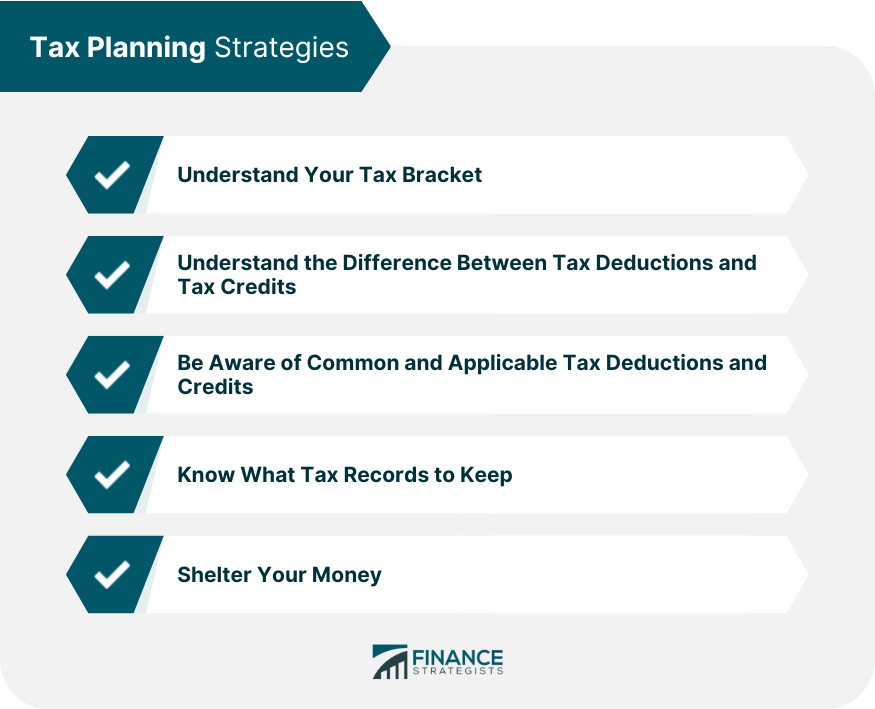Tax planning is the analysis of a client's overall financial situation and conditions in order to craft a financial plan that can be executed in the most tax-efficient manner. Tax planning is an essential component of a well-crafted financial plan. The purpose of tax planning is to ensure that, while a client is planning for retirement, college funds, investments, etc, they are also losing as little as possible to taxes. Tax planning brings together all the different components of a comprehensive financial plan and figures out how they will work together in the most tax efficient manner. Tax planning itself does not involve investments or accounts, but rather it refers to the direction of said investment and accounts in order to maximize tax savings. For example, say a client goes to a tax planner. They may work together to decide that opening an IRA is the best way to reduce the client's taxable income. In this way, the tax planner combines tax planning and retirement planning. Tax planning can also incorporate investments, donations to charities, trusts, gifts to heirs, and more. Tax planning also seeks to make the best use of all available tax deductions and credits. Some of the advantages of tax planning include: The ultimate goal of tax planning is to lower your taxes as much as possible. Understand your tax bracket: The United States tax system defines seven tax brackets that correspond to seven different levels of income. Knowing where you currently fall and where you expect to fall later is an important step in developing an appropriate tax plan. Understand the difference between tax deductions and tax credits: A tax deduction is an amount by which you can reduce your taxable income, which in turns requires fewer dollars of tax to be paid. A tax credit is an amount by which your owed taxes are directly reduced. In other words, if you owe $5,000 in income tax and have a $1,000 tax credit, then your income tax will be reduced to $4,000. Be aware of common and applicable tax deductions and credits: There are many deductions available that can significantly lower your tax burden. Make sure to research your options thoroughly. Know what tax records to keep: Having access to certain tax documents is essential for tax planning. Some of the documents you should hang on to include: Shelter your money: Sheltering your money means that you protect it from being taxed by moving it somewhere specific. Common ways to shelter your money include:
Have a question about tax planning? Click here.Advantages of Tax Planning
Tax Planning Strategies

Tax Planning FAQs
Tax planning is the analysis of a client’s overall financial situation and conditions in order to craft a financial plan that can be executed in the most tax-efficient manner.
The purpose of tax planning is to ensure that, while a client is planning for retirement, college funds, investments, etc, they are also losing as little as possible to taxes.
Some advantages of tax planning include minimizing taxes on your estate, reducing taxes on property left to heirs, and making the best use of available deductions and tax credits.
A tax deduction is an amount by which you can reduce your taxable income, which in turns requires fewer dollars of tax to be paid.
A tax credit is an amount by which your owed taxes are directly reduced.
True Tamplin is a published author, public speaker, CEO of UpDigital, and founder of Finance Strategists.
True is a Certified Educator in Personal Finance (CEPF®), author of The Handy Financial Ratios Guide, a member of the Society for Advancing Business Editing and Writing, contributes to his financial education site, Finance Strategists, and has spoken to various financial communities such as the CFA Institute, as well as university students like his Alma mater, Biola University, where he received a bachelor of science in business and data analytics.
To learn more about True, visit his personal website or view his author profiles on Amazon, Nasdaq and Forbes.















